| Author |
Message |
Thom R.

|
 Posted: Tue 02 Sep, 2008 6:19 pm Post subject: Some 17th c armour Posted: Tue 02 Sep, 2008 6:19 pm Post subject: Some 17th c armour |
 |
|
This is a drawing of a damaged effigy of the Fitzgerald monument in Cloyne Cathedral and dates to the early 17th c. It originally was a statue of a kneeling Sir John Fitzgerald in full armour and there were two other effigies of men at arms in full armour at one time (undocumented and destroyed) . Sir John died in 1612. It was accompanied by two slabs of sculptered arms which were still in a state of decent preservation. The helm seems a little stylized but the other weapons are realistically portrayed. The shield is interesting
 Attachment: 37.77 KB Attachment: 37.77 KB
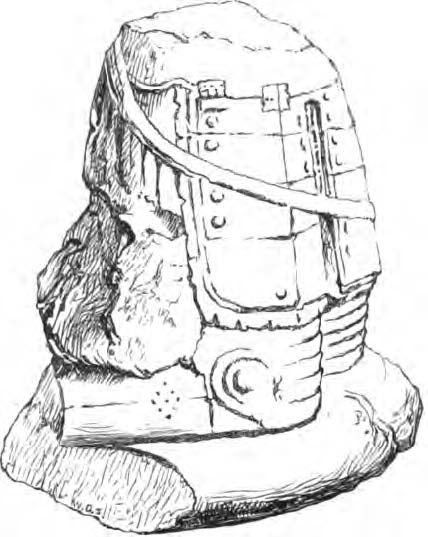
 Attachment: 48.47 KB Attachment: 48.47 KB

 Attachment: 48.71 KB Attachment: 48.71 KB

|
|
  |
 |
|
Kevin P Molloy
|
 Posted: Wed 03 Sep, 2008 2:39 pm Post subject: Posted: Wed 03 Sep, 2008 2:39 pm Post subject: |
 |
|
Thom R.
More great stuff, please keep it coming,and thanks.
Kevin Patrick Molloy
"The Prince of Firceall of the Ancient Sword is O'Molloy of the Freeborn Name"... O'Dugain(d.1372AD)
|
|
  |
 |
|
Kevin P Molloy
|
 Posted: Wed 03 Sep, 2008 2:42 pm Post subject: Posted: Wed 03 Sep, 2008 2:42 pm Post subject: |
 |
|
[I wrote]
>>>>>>>>>>>>>>>>>>>>>>>>>>>>>>>>>>>>>>>>>>>>>>>>>>>>>>>>>>>>>>>>>>>>>>>>>>>>>>>>>>>>>>>>>
This is great information you have posted I really appreciate it ,especially the shield, thanks. Pictures like this are hard to come by. Do you have anymore depictions of irish arms or armour from this source? And can anyone tell me what "painted in the spanish fashion" means as stated in the article?[/quote]>>>>>>>>>>>>>>>>>>>>>>>>>>>>>>>>
>>>>>>>>>>>>>>>>>>>>>>>>>>>>>>>>>>>>>>>>>>>>>>>>>>>>>>>>>>>>>>>>>>>>>>>>>>>>>>>>>>>>>>>>>>>
I don't know why I saw painted instead of "colouring" when I wrote the above post? So I guess it refers to the technique used to dye the shield? Since no one else answered I'm guessing thats the answer. Feel free to step in if you like.
Kevin Patrick Molloy
"The Prince of Firceall of the Ancient Sword is O'Molloy of the Freeborn Name"... O'Dugain(d.1372AD)
|
|
  |
 |
Thom R.

|
 Posted: Mon 08 Sep, 2008 2:10 pm Post subject: Some early dirks Posted: Mon 08 Sep, 2008 2:10 pm Post subject: Some early dirks |
 |
|
These two daggers/dirks were discovered together in County Carlow in the 1890s. I will just cut/paste the sketches (sorry for the quality its due to the original scan). They were dated at the time as being 12/13th century, post Norman invasion. Number I (attached) had an iron ferrule but the corrosion was so severe that the ferrule fell to pieces when excavated. There was no indication of a cross guard with that blade. Number II (illustrated below) had an iron cross guard of somewhat spatulate form on the ends and an iron ferrule for the handle. Blade lengths were approximately 15, and 15.25 inches. Single edged, and about 1/4 inch wide at the tang.
 Attachment: 29.43 KB Attachment: 29.43 KB

 Attachment: 71.9 KB Attachment: 71.9 KB
[ Download ]
|
|
  |
 |
Thom R.

|
 Posted: Mon 08 Sep, 2008 2:41 pm Post subject: some coats of arms Posted: Mon 08 Sep, 2008 2:41 pm Post subject: some coats of arms |
 |
|
these are rubbings of the shields on the tomb of Christopher St. Lawrence, 1st Baron of Howth with his wife Lady Plunkett. Sir Christopher was a defender of the pale seated at Howth and died in 1462. On the sides of the tomb are shields with some interesting family heraldry for several Anglo-Irish families for that period in Ireland.
From left to right
1. Plunkett and St Lawrence combined (although as was pointed out in the Journal of the Royal Society for Antiquaries [1908], in the wrong order?)
2. Le Poer family or the Butlers of Ormond
3. Plunkett
4. Flemings
5. Cusack
next row
6. Bellew
7. De Barry? or Hussey?
8. St Lawrence
9. Whites
10. the last shield seems to belong to the bishop or arch-bishop of the region.
 Attachment: 96.8 KB Attachment: 96.8 KB
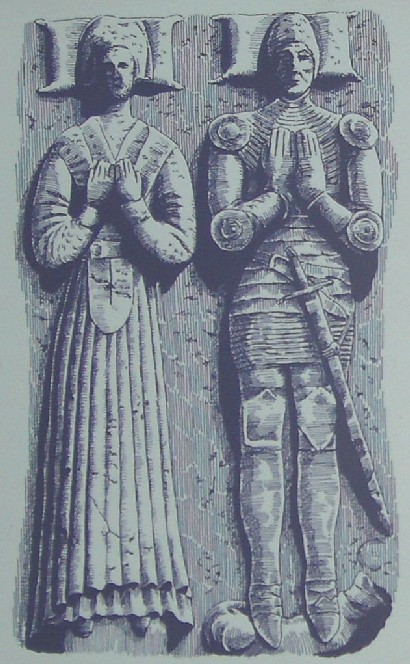
 Attachment: 36.17 KB Attachment: 36.17 KB
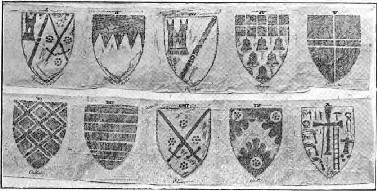
 Attachment: 54.53 KB Attachment: 54.53 KB
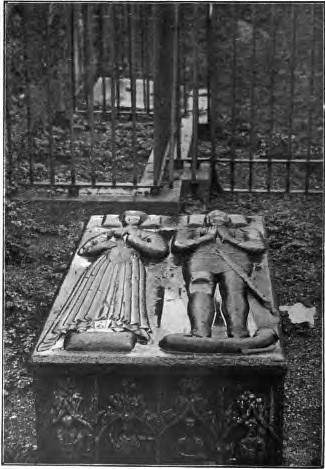
|
|
  |
 |
Thom R.

|
 Posted: Mon 08 Sep, 2008 2:59 pm Post subject: question Posted: Mon 08 Sep, 2008 2:59 pm Post subject: question |
 |
|
i have a question regarding the coat of arms posted above........
the dots represent a simplistic stylized version of the rose, is that not correct? and would have been used to show allegiance to Lancaster/York and later Tudor. is that not correct? thanks in advance, tr
 Attachment: 32.15 KB Attachment: 32.15 KB
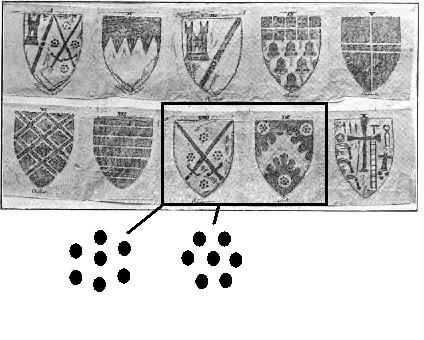
|
|
  |
 |
|
Kevin P Molloy
|
 Posted: Tue 09 Sep, 2008 3:45 pm Post subject: Posted: Tue 09 Sep, 2008 3:45 pm Post subject: |
 |
|
| Kevin P Molloy wrote: | | Ed McV wrote: | | Peter, I think you will find that "coloured after the Spanish fashion" means the method by which the targe was dyed. |
Let me clarify, what I am asking is what the "colors" are in "the spanish fashion" and what made the spanish fashion so distinct as to be mentioned in this way. Are there any examples? |
Well thanks to google I think I answered my own question. According to this website that I found the spanish, "painted" there shields in bright colors using oil based paint. I believe thats probably what the term "coloured after the spanish fashion" means.
http://historywired.si.edu/detail.cfm?ID=178
Kevin Patrick Molloy
"The Prince of Firceall of the Ancient Sword is O'Molloy of the Freeborn Name"... O'Dugain(d.1372AD)
|
|
  |
 |
|
Kevin P Molloy
|
 Posted: Tue 09 Sep, 2008 3:50 pm Post subject: Posted: Tue 09 Sep, 2008 3:50 pm Post subject: |
 |
|
| Kevin P Molloy wrote: | | Kevin P Molloy wrote: | | Ed McV wrote: | | Peter, I think you will find that "coloured after the Spanish fashion" means the method by which the targe was dyed. |
Let me clarify, what I am asking is what the "colors" are in "the spanish fashion" and what made the spanish fashion so distinct as to be mentioned in this way. Are there any examples? |
Well thanks to google I think I answered my own question. According to this website that I found the spanish, "painted" there shields in bright colors using oil based paint. I believe thats probably what the term "coloured after the spanish fashion" means.
http://historywired.si.edu/detail.cfm?ID=178 |
I believe these examples are close to what the painted Irish shields probably looked like.
http://www.electricscotland.com/WEBCLANS/m/macintyre_targes.htm
Kevin Patrick Molloy
"The Prince of Firceall of the Ancient Sword is O'Molloy of the Freeborn Name"... O'Dugain(d.1372AD)
|
|
  |
 |
|
Stephen Curtin
|
 Posted: Fri 26 Sep, 2008 11:37 am Post subject: Posted: Fri 26 Sep, 2008 11:37 am Post subject: |
 |
|
Hey guys, Does anyone know what swords were used in Ireland in the 17th century. Everyone knows of the ring-hilted swords of the 16th century but where they still popular in the 17th? Also how popular were basket-hilt broadswords and were they used as early as the confederate wars in the 1640's? Thanks in advance.
Éirinn go Brách
|
|
   |
 |
|
Mick Sullivan
Location: Chicago, Il Joined: 26 Nov 2008
Posts: 4
|
 Posted: Wed 26 Nov, 2008 3:37 am Post subject: Posted: Wed 26 Nov, 2008 3:37 am Post subject: |
 |
|
By far my favorite thread on this site! Thanks to all who contribute!
I have a serious question which I hope wont be seen as hijacking the thread:
In Derricke's Image of Ireland, the woodcut showing the Chief of the MacSweenys feasting, what are the two figures on the right hand edge above the harper doing? The legend is in latin, but I cannot make heads or tails of the description.
http://www.lib.ed.ac.uk/about/bgallery/Galler...55_jpg.htm
Not to be prurient or scatalogical, but just what the hell is going on here? Is this just Derricke's way of telling the traveller not to expect their accomodations to be en suite?
I swear to God my next post will be about ring-hilted swords, honest!
Mick
"Behavior that's admired is the path to power among peoples everywhere."
-Beowulf Poet, trans. S. Heaney
|
|
  |
 |
Thom R.

|
 Posted: Wed 26 Nov, 2008 11:39 am Post subject: Posted: Wed 26 Nov, 2008 11:39 am Post subject: |
 |
|
| Stephen Curtin wrote: | | Hey guys, Does anyone know what swords were used in Ireland in the 17th century. Everyone knows of the ring-hilted swords of the 16th century but where they still popular in the 17th? Also how popular were basket-hilt broadswords and were they used as early as the confederate wars in the 1640's? Thanks in advance. |
I think the simplest answer to your question about Irish arms and armour in the 1640s is "just about everything and anything they could get their hands on". Certainly baskethilted swords would have been used, as well as other swords of that period, rapier hilts, simple cross hilts, and spanish "bilbo" cup hilts. In short just about anything. Post Elizabeth I, there was this rather odd thing going on in Ireland, the crown actually allowed and even encouraged the Irish to be recruited by the Spanish. It appears that this was a double edged sword so to speak, on the one hand it got the surplus "ruffians" out of the country, yet at the same time it eventually created a number of experienced professional Irish regiments fighting in Flanders (mostly), many of whom came back to Ireland along with Preston and Owen Roe ONeill in the 1640s to fight for the Confederation. However, ONeill's letters clearly state that initially upon his return to Ulster, there was a rather sorry lack of weapons in general among the Confederation troops in Ulster in the early 1640s, which is why, at least initially, the Ulster Scots, despite being substantially outnumbered, were able to hold their own against ONeill for several years. This seems to have reversed in 1645 when weapons and gunpowder were brought to Ireland by the Spanish and which allowed ONeill to marshal an army of pike and shot that was strong enough to defeat Monroe at Benburb in 1646. At Benburb, ONeill had about 2/3rds pike and 1/3rd shot, and several "regiments" of lightly armoured horse. Monroe had about equal pike and shot, had cannons, and more heavily armoured cavalry. ONeill's horse used lances and swords, whereas Monroe's horse had buffcoats, cuirass, lances, swords, and some carbines. The Irish were mostly using matchlocks, the Scots had a fair number of wheel locks. The pike had dirks skeans and short swords as well as their pikes. ONeill's pike had morion helmets and at push of pike still threw short darts and javelins into Monroe's line. Breastplates and brigandine were apparently rare on both sides among the pikemen who seemed to rely mostly on padded arming shirts and vests. Interestingly, McCoy states that ONeill's pike heads were four flanged and rather small, whereas in Monroe's army the pike had flat broadheads. Thats about all we know from contemporary sources. Of course just a few years later Cromwell came to Ireland with a well armed professional force of over 10,000 men which had arms and armour typical of the English Civil War.
Please note I have attempted not to describe the politics of the time in Ulster at the beginning of the Confederation War as Irish vs Scots, as truly most of the men at Benburb on both sides were"Irish" in the sense of having been born and lived in Ireland, yet the fact remains that the core of ONeill's army were Irish gaels who had fought in the Irish regiments in Flanders for Spain, and the core of Monroe's army were Scots who had fought with Leslie in Scotland and England. I just do not want another pointless internet board flame war of what defines "Irish". tr
|
|
  |
 |
|
Stephen Curtin
|
 Posted: Thu 27 Nov, 2008 6:43 am Post subject: Posted: Thu 27 Nov, 2008 6:43 am Post subject: |
 |
|
Hi Tom and thanks for the long and thought out answer. I was already fairly knowledgable about the events of this time period but was having some trouble with finding out about what swords were used at this time, so thank again. I also completely agree about keeping the politics out of the discussion as it can be a touchy subject.
Éirinn go Brách
|
|
   |
 |
Sean Flynt

|
 Posted: Fri 28 Nov, 2008 8:39 am Post subject: Posted: Fri 28 Nov, 2008 8:39 am Post subject: |
 |
|
| Mick Sullivan wrote: | By far my favorite thread on this site! Thanks to all who contribute!
I have a serious question which I hope wont be seen as hijacking the thread:
In Derricke's Image of Ireland, the woodcut showing the Chief of the MacSweenys feasting, what are the two figures on the right hand edge above the harper doing? The legend is in latin, but I cannot make heads or tails of the description.
http://www.lib.ed.ac.uk/about/bgallery/Galler...55_jpg.htm
Not to be prurient or scatalogical, but just what the hell is going on here? Is this just Derricke's way of telling the traveller not to expect their accomodations to be en suite?
I swear to God my next post will be about ring-hilted swords, honest!
Mick |
I regret to inform you that these men are believed to be "braigetori"--professional flatulists. This is what passed for entertainment, if you'll pardon the pun.
http://en.wikipedia.org/wiki/Flatulist
-Sean
Author of the Little Hammer novel
https://www.amazon.com/Little-Hammer-Sean-Flynt/dp/B08XN7HZ82/ref=sr_1_1?dchild=1&keywords=little+hammer+book&qid=1627482034&sr=8-1
|
|
   |
 |
David McElrea

|
 Posted: Fri 28 Nov, 2008 1:10 pm Post subject: Posted: Fri 28 Nov, 2008 1:10 pm Post subject: |
 |
|
Interesting.
I had always heard they were warming their bare posteriors by the fire, Derrick showing, thusly, how "uncouth" Irishmen were. It would be helpful to know the translation of the Latin.
I'm not too sure of the first stanza, maybe "A spectator watches thus, so I instruct my relatives"
The second stanza is something like, "I too am superior to all in lacking good taste"...
Edited a bit. Someone who remembers their Latin please step in now and tell us what it actually says.
|
|
  |
 |
|
Mick Sullivan
Location: Chicago, Il Joined: 26 Nov 2008
Posts: 4
|
 Posted: Fri 28 Nov, 2008 6:49 pm Post subject: Posted: Fri 28 Nov, 2008 6:49 pm Post subject: |
 |
|
Go raibh mile maith agat Sean agus David!
Thank you for answering a serious question which I was afraid would be misconstrued as just 'taking the p1ss". I've wondered about those characters and thought perhaps they were warming their posteriors as well, but the legend loses me after "A spice spectator..."
So, they're just early ancestors of Joe Pujol, known to history as Le Petomane!
Here is another question, all the images are from the Trinity College Library collection.
In studying the illustrations, it seems that the one of Richard more closely resembles an Elizabethan Irish nobleman, since he appears in full plate armour and wears what appears to be a 16th century hat. I wonder if there is any chance that the portraits of Seann Mac William Burke and Richard Mor Burke were cross-labeled by the binder of the manuscript.
I understand that development in arms and armour in Ireland were behind that on the continent, but I have a hard time believing that the illustrator thought that plate armour predated chain mail, even if he were not a student of military history. The plate armor and Elizabethan hat on the figure labeled 'Richard' strikes me as anachronistic as a modern print of Napoleon's troops being strafed by Spitfires. Any thoughts?
Mick
 Attachment: 23.79 KB Attachment: 23.79 KB
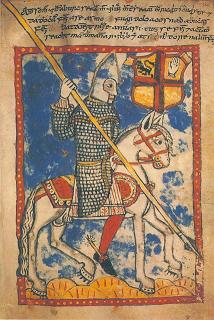
Labeled Seann Mac William Burke, d. 1580. (MS1440 fol 24r)
It depicts a mounted warrior wearing a sugarloaf helm with a chain or scale hauberk over a gambeson, with rowel spurs and no stirrups. It is reproduced as plate 8 in Dr. Hayes-McCoy's book Irish
 Attachment: 20.76 KB Attachment: 20.76 KB
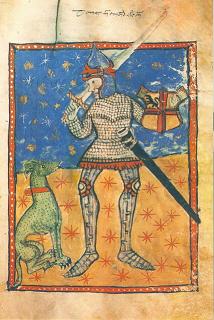
This one is labeled Thomas Mac William Burke, d.1402. (MS1440 fol 21r)
It depicts a man with a chain or scale hauberk with plate armour leg-protection. He is obviously about to smack the dog with the flat of the blade for putting toothmarks through the
 Attachment: 19.36 KB Attachment: 19.36 KB
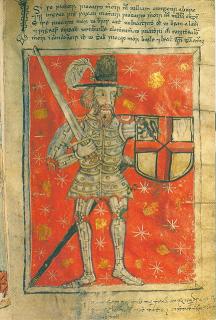
This is labeled Richard Mor Burke (forgive the lack of fadas!), d.1243. (MS1440 fol 19)
It depicts a man in full plate armour wearing a large felt hat with a white feather. It is also found in Hayes-McCoy's Irish Battles as plate 14, labeled "16th Centu
"Behavior that's admired is the path to power among peoples everywhere."
-Beowulf Poet, trans. S. Heaney
|
|
  |
 |
Randall Moffett

|
 Posted: Fri 28 Nov, 2008 11:44 pm Post subject: Posted: Fri 28 Nov, 2008 11:44 pm Post subject: |
 |
|
As far as the 16th century one the armour, hat everything is from that era for sure. The other two look a bit more on but I'd be wary to use anything in art depicting an event or person 100 or more years later as likely. You get two trends that are fairly common in artwork of the period. Trying to depict what they would have looked like or simply placing them in current styles. Even if it were done to try and show what they wore in the past the further back often the less likely it is. You often see late 14th artwork of Becketts murder shown with late 13th or early 14th armour etc. Clearly it was the artist trying to depict outdated armour but not outdated enough...
RPM
|
|
  |
 |
M.J. Beukers

Location: Netherlands Joined: 22 Sep 2009
Posts: 7
|
 Posted: Tue 17 Nov, 2009 8:11 am Post subject: birin and irish javelins Posted: Tue 17 Nov, 2009 8:11 am Post subject: birin and irish javelins |
 |
|
Hi,
I am a member of a re-enactment group portraying Galloglass warriors and kerns as a part of the court of Angus Og (period: around 1307).
We want to make and use traditional Irish weapons.
What I am wondering is if there were birin (throwing darts) around in our period and if they used flights.
If so what kind of material, i have read that leather was probably used (rawhide?)
This thread is great there is a lot of valuable info in it!
I was wondering how Sean got on with his birin/darts. (maybe he could post some pictures of his work?)
Thanks
Maurice
|
|
  |
 |
Sean Flynt

|
 Posted: Tue 17 Nov, 2009 9:07 am Post subject: Re: birin and irish javelins Posted: Tue 17 Nov, 2009 9:07 am Post subject: Re: birin and irish javelins |
 |
|
| M.J. Beukers wrote: | Hi,
I am a member of a re-enactment group portraying Galloglass warriors and kerns as a part of the court of Angus Og (period: around 1307).
We want to make and use traditional Irish weapons.
What I am wondering is if there were birin (throwing darts) around in our period and if they used flights.
If so what kind of material, i have read that leather was probably used (rawhide?)
This thread is great there is a lot of valuable info in it!
I was wondering how Sean got on with his birin/darts. (maybe he could post some pictures of his work?)
Thanks
Maurice |
Hello and welcome! I think you'll find lots of information here. As for the darts--I thought I posted a photo of my first attempt, but I can't find it. Here's the thread in which we carried on a pretty good conversation:
http://www.myArmoury.com/talk/viewtopic.php?t...ight=darts
My first darts were too light. I still think that the largest medieval arrow head you can find would work, but I think you need a shaft closer to .75 inches in diameter, tapered down to the head or "barelled". If you can find a small barbed spearhead, so much the better (probably any competent blacksmith can make those for you). I couldn't find a plain hardwood dowel of that size and length but I did find a perfect haft in the paint section of a hardware store. This was made as an extension haft for a paint roller brush. It has a threaded metal head that screws into the base of the roller. You can easily remove that, taper the haft and otherwise adjust it as you like. That, plus a large "swallowtail" arrow head should be a much better weight. Fletch it with leather or wood and it should be very nice to throw.
As for the chronology: Darts of this size seem to have been in use by the ancient Romans and up through the Migration Period. The Spanish used Javilenineers in the 100 Years War, and Javileneers are shown in European painting through the 15th c. It seems likely they would have been in use ca. 1300, but I don't know if there was any status implied by the weapon. It might have been more common among the attendants of elite warriors (the Kern, for example) than among the warriors themselves--as seems to have been the case in the 16th c.
I would say that fletching is an appropriate option. It's value was certainly understood from ancient times and European artwork shows both fletched and plain. The civic darts you'll see in Ireland today are fletched, so there is a strong Irish tradition for fletched darts. The leather thong or "Ammentum" is ancient, too, and we know it was used on Irish darts as late as the 16th c., so I see no reason not to use it in 1300. Here's an excellent, illustrated guide to using that technology:
http://www.myArmoury.com/talk/viewtopic.php?t=7746&start=0
-Sean
Author of the Little Hammer novel
https://www.amazon.com/Little-Hammer-Sean-Flynt/dp/B08XN7HZ82/ref=sr_1_1?dchild=1&keywords=little+hammer+book&qid=1627482034&sr=8-1
|
|
   |
 |
M.J. Beukers

Location: Netherlands Joined: 22 Sep 2009
Posts: 7
|
 Posted: Tue 17 Nov, 2009 9:25 am Post subject: Posted: Tue 17 Nov, 2009 9:25 am Post subject: |
 |
|
Thanks Sean,
again a lot of valuable info!
I will post the results of our experiments with the darts on myArmoury.
Might take a while though, probably in the beginning of next year.
Maurice
|
|
  |
 |
Sean Flynt

|
 Posted: Tue 17 Nov, 2009 10:26 am Post subject: Posted: Tue 17 Nov, 2009 10:26 am Post subject: |
 |
|
| M.J. Beukers wrote: | Thanks Sean,
again a lot of valuable info!
I will post the results of our experiments with the darts on myArmoury.
Might take a while though, probably in the beginning of next year.
Maurice |
I'm eager to see your results! I still have the swallowtail arrow heads I bought for my improved project, but haven't yet hafted them. I also still have the brass tacks and plywood disk I cut to make an Irish target--two projects on the "someday" list.
What do you plan to use for your birin heads?
-Sean
Author of the Little Hammer novel
https://www.amazon.com/Little-Hammer-Sean-Flynt/dp/B08XN7HZ82/ref=sr_1_1?dchild=1&keywords=little+hammer+book&qid=1627482034&sr=8-1
|
|
   |
 |
|
|
You cannot post new topics in this forum
You cannot reply to topics in this forum
You cannot edit your posts in this forum
You cannot delete your posts in this forum
You cannot vote in polls in this forum
You cannot attach files in this forum
You can download files in this forum
|
All contents © Copyright 2003-2024 myArmoury.com — All rights reserved
Discussion forums powered by phpBB © The phpBB Group
Switch to the Basic Low-bandwidth Version of the forum
|

